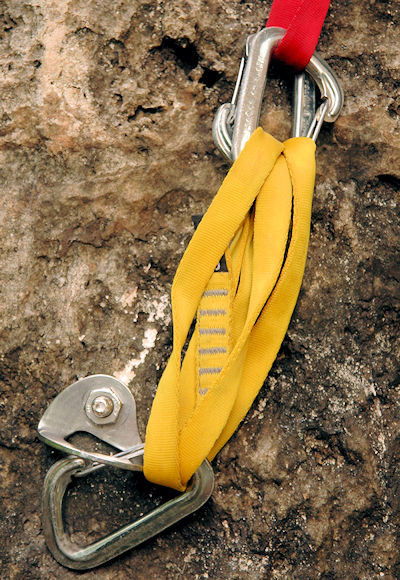15.D.06 Synthetic Web Slings.
- Synthetic Web Slings must be inspected for the following:
- (1) Acid or caustic burns;
- (2) Melting or charring of any part of the sling;
- (3) Snags, holes, tears, or cuts;
- (4) Broken or worn stitches;
- (5) Excessive abrasive wear;
- (6) Knots in any part of the sling;
- (7) Wear or elongation exceeding the amount recommended by the manufacturer;
- (8) Excessive pitting or corrosion, or cracked, distorted, or broken fittings;
- (9) Other visible damage that causes doubt as to the strength of the sling.
- Synthetic web slings must not be allowed to be used in contact with objects or at temperature in excess of 194ºF (90ºC) or below -40ºF (40ºC).
Note: Some synthetic yarns do not retain their breaking strength during long term exposure above 140ºF (60ºC).
15.D.07 Synthetic Round Slings.
- New slings (before initial use) must be marked by the manufacturer to show the following, in addition to items required in Section 15.D.01.c:
- (1) The core material;
- (2) The cover material if different from the core material.
- Synthetic Round Slings must be inspected for the following and where any such damage or deterioration is present, remove the sling or attachment from service immediately:
- (1) Missing or illegible sling identification;
- (2) Acid or Caustic burns;
- (3) Evidence of heat damage;
- (4) Holes, tears, cuts, abrasive wear, or snags, that expose the core yarn;
- (5) Broken or damaged core yarns;
- Welding spatter that exposes the core yarns;
- (6) Knots in the round sling body, except for core yarn knots inside the cover;
- (7) Discoloration and brittle or stiff areas on any part of the sling;
- (8) Pitted, corroded, cracked, bent, twisted, gouged, or broken fittings;
- (9) Other conditions that cause doubt as to the continued use of the sling.
- Synthetic round slings must not be allowed to be used in contact with objects or at temperature in excess of 194ºF (90ºC) or below -40ºF (40ºC).
Note: Some synthetic yarns do not retain their breaking strength during long term exposure above 140ºF (60ºC).
Knowledge Check Choose the best answer for the question.
15-8. Synthetic web slings must not be allowed to be used in contact with objects or at temperature in excess of _____.
You forgot to answer the question!

